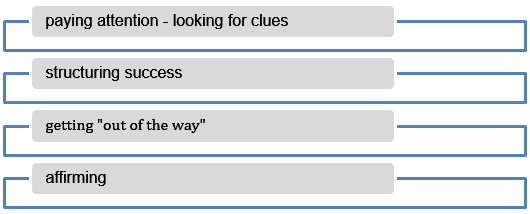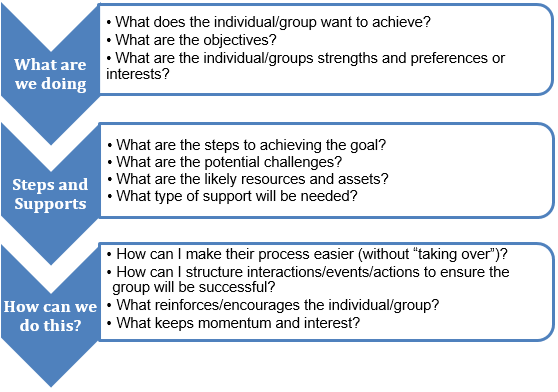Key Facilitation Skills & Tasks
What does Facilitation mean?
Facilitation means – to “make easy”, or to “ease the process”. With this in mind, the Facilitators role is to “make it easier” for an individual (or a group) to achieve their aspirations and key objectives.
Facilitators are ‘neutral’ in their stance, their role is to guide the proceedings, without getting involved in the specific content and opinions involved.
The Facilitator is not the overall decision maker, nor does the Facilitator hold all the power or authority in the group. The Facilitators role is to guide the process so that every voice is heard (equitable partnership) and that decisions are decided by the group by reaching agreement (not by sub groups or by one or two individuals).
Decisions are made through a process that allows for equitable discussion and decision making. The Facilitator may be required to assist the group to reach ‘agreement’ if there are differences of opinion.
Facilitator Values
- the process used should enhance the person’s sense of worth
- people participate best when they contribute their opinions and experiences
- provide content that is relevant to the group and inspires possibilities (ie, use of success stories)
- people are more likely to integrate new ideas when they can visualise how this can happen
- Facilitators should recognise the achievements of group members
- Facilitators may provide necessary information and be a catalyst for learning/action…but ultimately the group members are responsible for what they learn/do.
- monitoring must be built into meetings – to ensure relevance and effectiveness
Key tasks associated with Facilitation
- provide a secure environment
- the facilitator remains neutral throughout the process
- keep the content (what is being discussed) separate form the process (how things are discussed)
- break group tasks down into small achievable steps
- model what you want (honesty, respect, openness)
- pay attention to the physical comfort of the group
- have regular process checks (how are people feeling?)
- look for common threads and explore options
- develop a workable strategy/outcome
FACILITATION – KEY BEHAVIOURS

FACILITATION DIAGRAM

Key Facilitation Skills
Communication skills (refer to the Interpersonal Communication Skills resource)
- creating safe environments where people can express their thoughts and opinions
- positive reframing – can I assist the individual to see possibilities not problems?
Conflict Management (refer to the Group Conflict Resolution Model resource)
- use win/win concepts and practices
- view conflict as constructive
- appreciate diversity
Planning (refer to the Planning and Monitoring resource)
- define the groups key objectives
- obtain a clear picture of local contacts and resources
- break tasks down into achievable steps
- asset development e.g. community, person, staff, family and systems
Networking
- comprehensive local knowledge – developing trusting and mutual connections
- develop relationships with key community members, community groups and allied social services
Cultural Competency and Optimism
- informed and respectful ways of working
- strengths based practice
Asking questions, perception checking and paraphrasing
One of the powerful tools a facilitator has is ‘how’ they ask questions. Our aim is to encourage a person to express all of the important thoughts and feelings they are experiencing.
We do this by using open-ended questions. Open-ended questions typically begin with words such as “What”, “Why” and “How”, or phrases such as “Tell me about…”. Often they are not technically a question, but rather a statement that implicitly asks for a response. These questions allow the individual to explore/express the thoughts/feelings that they believe to be most important.
Open questions:
“What’s important to you?”
“What will make your community stronger?”
“Tell me about your relationship/connection with…..?”
Closed-ended questions encourage a short or single-word answer (such as ‘yes’ or ‘no’). These questions enable the questioner to rapidly elicit factual information. Closed questions are not effective in facilitating a ‘warm’ and flowing dialogue, but are useful to elicit information quickly.
Closed questions:
“do you think it’s important to vote?”
“do you think we should focus on the walkways near ……?
“do you get on with…..?”
Perception checking and paraphrasing
The AIM of perception checking is to clarify what has been expressed so you can:
- check your own understanding
- demonstrate to the individual or group that you are attempting to follow what they are expressing.
You can perception check by PARAPHRASING (saying the important things back to the person) so they can either:
- agree and go on with more detail, or
- disagree, and restate what they are expressing.
Perception checking does not involve interpreting, judging or analysing what has been expressed. Perception checking is like a mirror so you can see whether you have understood or whether you have inadvertently heard incorrectly (distorted a message).

